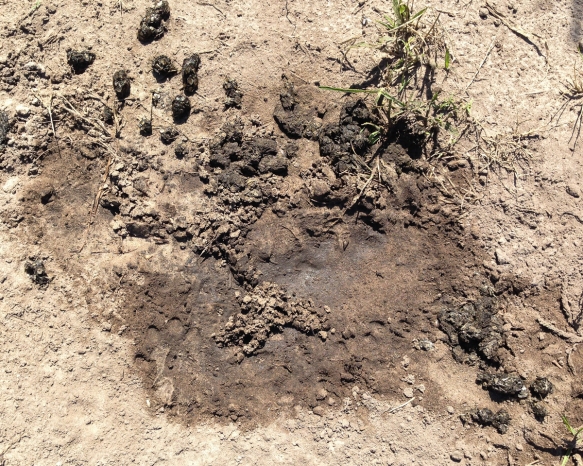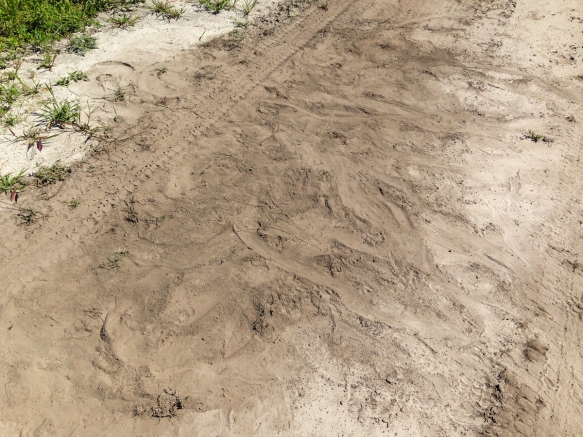…neither fish nor beast is the otter.
~Ted Hughes
Driving down a dirt road last week on the Pungo Unit, I spotted something up ahead. It wasn’t a critter, but rather a distinctive sign made by an animal.
As I got closer, I could see it was a very large area that had been marked by a River Otter, although by the looks of it, undoubtedly more than one animal. River Otters are common in the canals at Pocosin Lakes National Wildlife Refuge and have regular spots they use to cross the roads from one canal to another. I had seen tracks and scat in this general location before, but never this large of an area with this much sign. There were a bunch of squiggles in the sandy substrate indicting the otters had rolled around in a patch of road measuring about 6 or 7 feet across. River Otters roll to maintain their fur. Rolling fluffs it up, cleans and dries the fur, and helps distribute the oils that are critical to maintaining its insulating and waterproofing qualities.

River Otter scat and urine at the rolling location – notice the tracks on the lower edge of wet area
Rolling also serves as a means of communication amongst otters by scent-marking as they roll. They frequently defecate and urinate in or adjacent to these areas (and regularly used haul-outs) as a means of scent-marking. To make sure other otters know they have been in the neighborhood, River Otters have scent glands on their hind feet as well as highly developed anal scent glands (the latter is typical of all members of the weasel family).
A common indicator of their presence are small mounds of vegetation and debris scraped into a pile by an otter and topped with scat in locations where they regularly haul out or have pathways to water.Their scat is usually composed of fish scales and is tubular in shape, although you often see it simply in a small pile.
Another common component are bits and pieces of crayfish, which usually have a reddish-pinkish tint. There is usually a distinctive musky-fishy smell associated with these locations, especially if recently used. With so many ways to scent mark, River Otters must be constantly checking on the comings and goings of friends, relatives, and potential competitors in their neighborhood.
While I did not see an otter on that day, they left ample evidence of their presence. It was fun to imagine three or four of them laying and rolling in the road, leaving their calling card for the next otter to come by. And they probably did it in that playful manner we so often associate with these beautiful animals. I have seen otter here several times and had the privilege of watching them hunt and go about their business in many other areas around the country. Whenever I see them, it always brings a smile to my face…they just seem to have that affect on people.






Hi Mike, my friend Sharon and I still want to do a nature workshop with you. Could you add us to others going with you as we don’t know others to join us and it is too expensive for the two of us!! North and South Carolina and Virginia all sound great!!
Mike, your posts are a bright spot in an inbox full of complaints and dry newsletters. Today’s post made me smile, but it also made me glad I had already eaten breakfast. I was NOT prepared to see your photo of otter scat filled with fish scales!
Thanks to both of you. And Bianca, I thought I might be pushing it having photos of scat in two recent blogs:)
Loved this article on the River Otters. Had seen them at Mattamuskeet but never at Pungo. Great post.